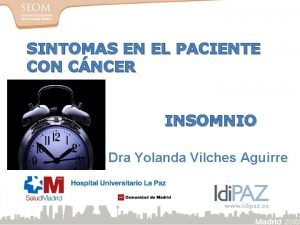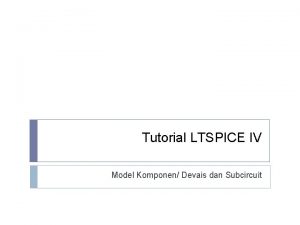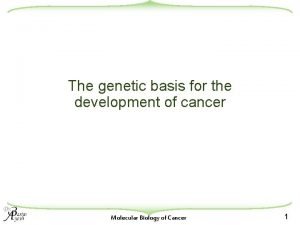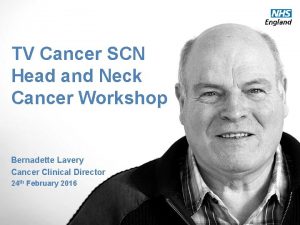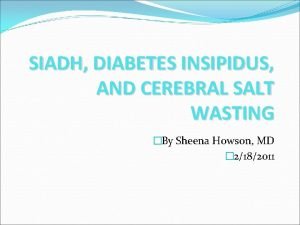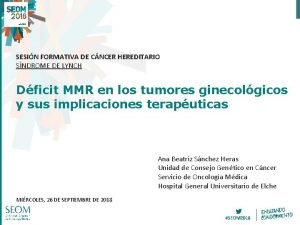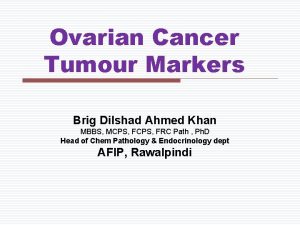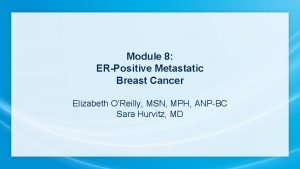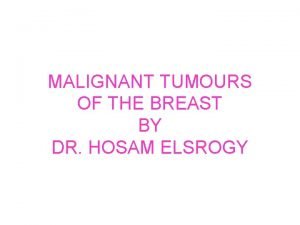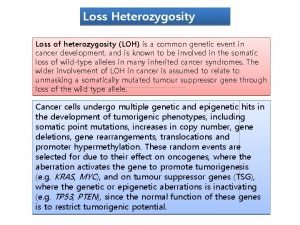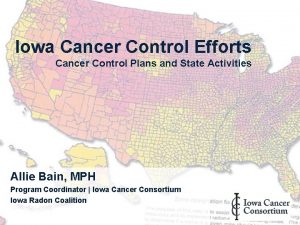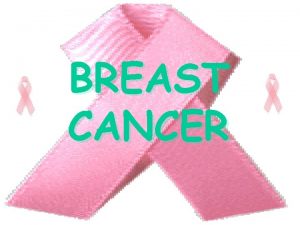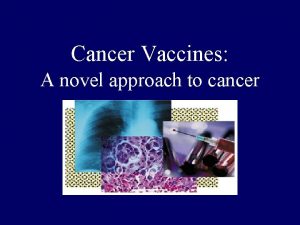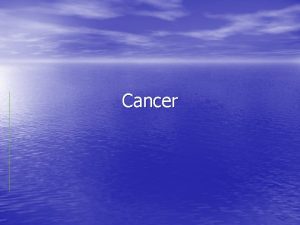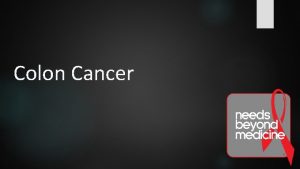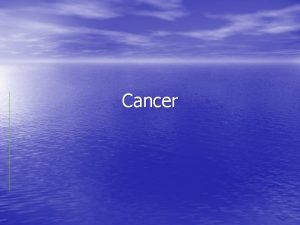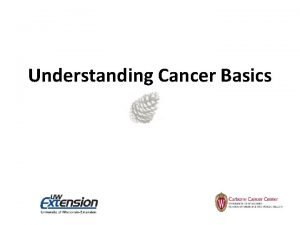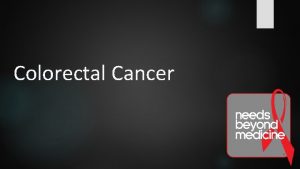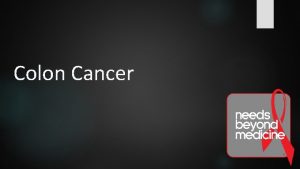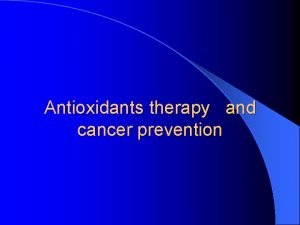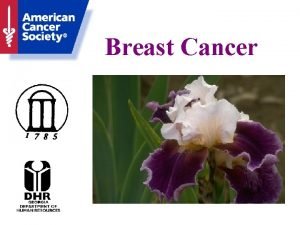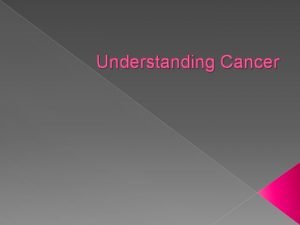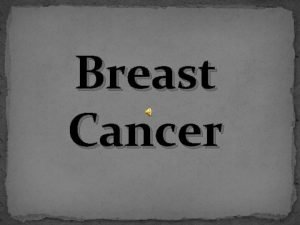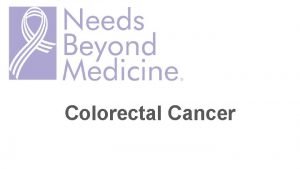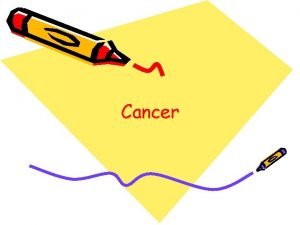Cancer Control What is cancer Cancer is a


























- Slides: 26

Cancer Control

What is cancer? • Cancer is a diverse group of diseases characterised by the proliferation and spread of abnormal cells, which cannot be regulated by normal cellular mechanisms and grow in an uncontrolled manner. The National Health Priority Areas initiative has identified a focus on: • Lung • Skin • Cervix • Breast, • Colorectal, • Prostate cancers • Non-Hodgkin's lymphoma

Which cancers were the most common in 2007? In 2007, the most commonly reported cancers were: • Prostate cancer (19, 403 cases) • Bowel cancer (14, 234 cases) • Breast cancer (12, 670 cases) • Melanoma of the skin (10, 342 cases) • Lung cancer (9, 703 cases).

Cancer control Reason why Biological NHPA risk factors Behavioural risk factors Health promotion strategies Direct costs Indirect and intangible costs • Leading • Genetics cause of • Age death • Leading cause of total burden of disease • More than 39, 000 deaths each year • Smoking (lung cancer) • UV radiation (skin cancer) • High fibre diet • Screening and vaccination programs • Sun. Smart • In 2000 -01, direct costs of $2. 8 billion • Cost to individuals – medication, treatment and surgery • Personal suffering • Feeling of loss • Time off work

Skin Cancer Australia has one of the world’s highest rates of skin cancer. Two in every three Australians will be diagnosed with skin cancer by 70 years of age. • 95% of skin cancer is preventable. Melanoma is the most dangerous type of skin cancer, and is also the most common cancer among people aged 15– 44 years


Determinants • Men are twice as likely to die from melanoma than women. • Sun exposure due to outdoor careers • Not using sun screen • Fashion of tan being more attractive • Sun protection is a lifelong behavioural choice. Each time the skin is exposed to uv radiation, change and damage occurs in the skin cells. What are the factors you think stand in the way of following the sun safe tips?

Program- Sun Smart Slip, slop, slap, seek, slide • Slipping on sun-protective clothing – that covers as much skin as possible. • Slopping on SPF 30+ sunscreen – make sure it is broad spectrum and water resistant. Put it on 20 minutes before you go outdoors and reapply every 2 hours afterwards. Sunscreen should never be used to extend the time you spend in the sun. • Slapping on a hat – that protects your face, head, neck and ears. • Seeking shade whenever possible. • Sliding on some sunglasses – make sure they meet Australian standards. • Limiting sun exposure during the hours of peak sun intensity (10 am to 2 pm or 11 am to 3 pm daylight saving time. )

Prostate Cancer • Prostate cancer is the most commonly reported cancer in males but does have a relatively high survival rate. The prostate gland is part of the male reproductive system. It produces some of the fluid that makes up semen. Prostate cancer affects one in nine Australian men and is common in the over-65 age group. • In 2008, 20 750 men were diagnosed with prostate cancer,


Prostate screening • The two common tests for prostate cancer are a digital rectal examination (DRE), and a prostatespecific antigen (PSA) blood test. • Men over 40 are recommended to have regular prostate checks. • If results of the PSA test or the DRE are abnormal, a urologist will likely recommend a biopsy, where small samples of tissue are removed from the prostate and examined.

Bowel cancer • One in 12 people are diagnosed with bowel cancer by the age of 85. Every week 277 new cases are diagnosed and 75 Australians die from this disease. It is the second-most common cause of cancer death in Australia • If caught in time, 90% of cases can be successfully treated.

National Bowel Cancer Screening Program Medicare Australia and the Department of Health and Ageing are working together to implement this program. Currently fewer than 40% of bowel cancers in Australia are detected early. Bowel cancer screening involves testing for bowel cancer in people who do not have any obvious symptoms of the disease. Screening involves a test called a Faecal Occult Blood Test (FOBT), which involves an individual sending a sample to a laboratory for analysis. The goals for this program are to reduce the incidence and mortality rate of bowel cancer through screening to detect abnormalities early.



Cervical Cancer • Pap smears • HPV vaccines

Breast Cancer • Breast cancer affects one in nine Australian women. It is the most common cancer for Victorian women, with almost 3, 700 diagnoses in 2012. Breast cancer can occur at any age, but it is most common in women over the age of 60.

Risk factor • The exact cause of breast cancer is unknown, but factors that seem to increase risk include: • gender – being a woman • getting older – women over 50 years of age are invited to take part in yearly mammograms to screen for breast cancer • heredity – having several close family members (mother, sister or daughter) who have had breast cancer • not having children or having children after the age of 30 • early age at first period • later age of natural menopause (55 years or older) • alcohol intake (more than one standard drink per day) • obesity or gaining a lot of weight after menopause • using the contraceptive pill – the risk is higher while taking the pill and for about ten years after stopping use • using hormone replacement therapy (HRT) – also known as hormone therapy (HT)

Check your breasts • By regularly checking your breasts, you may be able to recognise changes that could be a sign of breast cancer. Such changes include: thickening of the tissue • a lump or lumpiness • discharge from the nipple • an inverted or ‘turned-in nipple’ (unless the nipple has always been turned in) • puckering or dimpling of the skin • a change in the shape of the breast or nipple • a painful area • anything that is not ‘usual’ for you. • Please be aware that some of these symptoms occur without any serious disease being present. Nine out of 10 breast changes are not breast cancer. However, just to be sure, your doctor should check any unusual breast change.


Screening mammography • Screening mammography is provided as a free service for women aged 50 to 74 through the Breast. Screen Australia program. It is used to detect breast cancer early, when you are well and have no obvious breast symptoms. Screening mammograms can detect breast cancers that are too small to be felt by you or your doctor. Mammograms taken at different times can later be compared to show changes in breast tissue over time.


The Mc. Grath Foundation • not-for-profit, community organisation was founded by Jane and Glenn Mc. Grath • Complete activity 11. 13 on page 383

Non Hodgkin's lymphoma • Non-Hodgkin lymphoma is a type of cancer that develop in lymphatic tissue. • In non-Hodgkin lymphoma, the lymphocytes become damaged. They grow abnormally and multiply uncontrollably, causing the lymph nodes to enlarge and form painless lumps called tumours. As the abnormal lymphocytes replace the normal ones, the immune system becomes less effective.

Explain two examples of how this program can optimise the health of Australian adults.

 Problemas de sueño y dolor al padecer cáncer
Problemas de sueño y dolor al padecer cáncer Primary control vs secondary control
Primary control vs secondary control Process control and product control
Process control and product control Reynolds transport theorem
Reynolds transport theorem Stock control e flow control
Stock control e flow control Control volume vs control surface
Control volume vs control surface Negative vs positive control operon
Negative vs positive control operon Negative control vs positive control
Negative control vs positive control Jelaskan tentang error control pada data link control?
Jelaskan tentang error control pada data link control? Control de flujo y control de errores
Control de flujo y control de errores Negative control vs positive control examples
Negative control vs positive control examples Control flow errors
Control flow errors Scalar control vs vector control
Scalar control vs vector control Salin teks di foto
Salin teks di foto Symptoms of metal fume fever
Symptoms of metal fume fever Tnm stage lung cancer
Tnm stage lung cancer The soldier poem meaning
The soldier poem meaning The genetic basis of cancer
The genetic basis of cancer Thames valley strategic clinical network
Thames valley strategic clinical network Difference between di and siadh
Difference between di and siadh Clasificacion molecular cancer de endometrio
Clasificacion molecular cancer de endometrio Picis y cancer
Picis y cancer Hpv oral cancer
Hpv oral cancer Ovarian cancer marker
Ovarian cancer marker Cdk breast cancer
Cdk breast cancer Breast ca tnm staging
Breast ca tnm staging Loss of heterozygosity
Loss of heterozygosity
